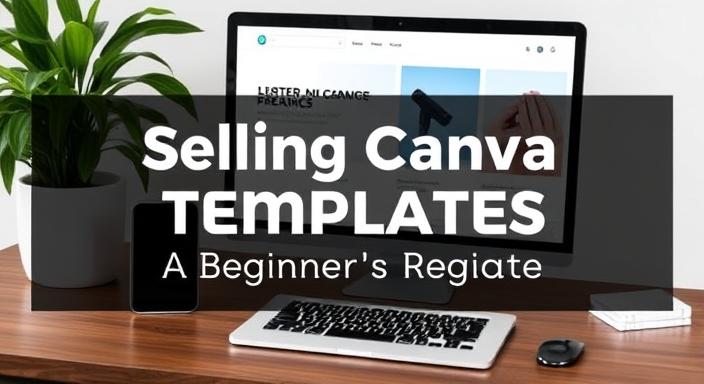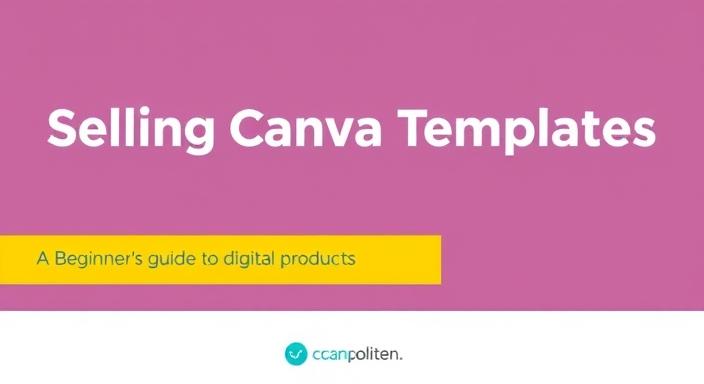Selling Canva templates for profit
I. Main Themes & Key Takeaways:
High Earning Potential: Niche Canva templates can create significant income opportunities. Creators can make between tens of thousands and over half a million dollars with different templates.
Convenience Sells: Customers choose templates to save time and effort. They simplify design, sizing, and content creation.
Repurposing and Duplication for Efficiency:
To make great template collections, like social media bundles and custom books, reuse elements and copy pages. Also, explore Canva’s styling options.
Make the Most of Canva: Use Canva’s frames, color palettes, font pairs, and stock images. This helps you create templates on time.
Using External Tools:
Tools like Photopea let you make custom frames. ChatGPT helps with generating content. Together, they make template creation much easier.
Selling as Digital Products (PDFs):

To sell Canva templates, create a shareable link for your template first. Then, embed this link in a well-designed, clickable PDF document.
II. Most Important Ideas and Facts:
A. Lucrative Canva template niches and examples:
Sublimation Frames: This template is easy to make and very profitable.
Experts estimate the “Tumbler sublimation frame template” at over $29,000. The “skinny Tumblr sublimation frame template” is over $44,000.
Niche stores specializing in these can earn “over $400,000.”
Give customers frames that let them drag and drop images onto mugs and tumblers for printing. “People buy them mainly because they’re convenient.” selling canva
Can include standard shapes or “any image you like in a custom frame.” Experts estimate that one bundle of custom frames made “over $700,000.”
Social Media Bundles: “Making an insane amount of money.”
Examples: Instagram bundle with post templates estimated at “over $100,000.” Experts estimate that a specialized store made “over $520,000.”
Key Trick: “Repurpose them.” Make a simple layout first. Then, use Canva’s “styles” and “color palette tab” to create many variations. Change the colors and fonts for different looks.
Business Document Supply Kits: Selling Canva
“Many people are earning money by creating technical documents for businesses. This includes invoices and client intake forms.” selling canva
Examples:
- Wedding photography client supply kit: over $118,000.
- Event planning business kit: over $50,000.
- Facial treatment business kit: over $186,000.
“
**Creation Tips:** Focus on text boxes, shapes, and some graphical elements. Space them out to improve their appearance.” Use the “duplicate button a lot” and use “Chat GPT” to generate content. For example, ask, “What questions should I ask new clients?”
Customizable Books (Workbooks, Memory Books): “These are generating significant revenue.”
Examples: Business workbook estimated “over $147,000.” Memory book using Canva frames for photos, estimated at “over $29,000.”
Creation Tips: Start with an A4 booklet and ensure you turn on the margins for the text.
You can repurpose pages by:
- Duplicating them.
- Using the color palette feature.
- Moving boxes and shapes around.
This helps you create new layouts in a short amount of time.
Travel Itineraries: “Very popular with customers right now.”
Examples:
- Italy itinerary: over $69,000
- Bachelorette trip itinerary: over $33,000
- Japan itinerary: over $64,000
- Another Italy itinerary: over $215,000
“
Key Feature: Add “starter content” like placeholder-free photos for activities. Use Canva’s image frames and access over 100 million stock images from Pixabay and Pexels. selling canva
B. Step-by-Step Template Creation Techniques:
Custom Canva Frames:
Log in to Canva, and we recommend using a Pro trial for tools like the background remover.
Create a new, large Canva project. Use a clear title and subtitle that explain how to use it.
Use “free images and fonts” for accessibility by free Canva account users.
Go to Photopea (a free Photoshop clone) and create a new project with the same size as Canva’s and a resolution of 96 DPI.
Upload the desired image (e.g., a rectangle with specific dimensions).
Convert the image to a frame:
- Click Layers.
- Right-click the image layer.
- Select Pixels.
- Click the “pass button.”
- Then, click the “selection to path button.”
“
Open the Layer menu -> Under Vector Mask, select “Current Path.”
Save it as a PDF and upload it back to Canva.
Open the PDF in Canva, delete the image, and leave the frame.
Move the frame to the main page. Duplicate and repeat for different sizes/shapes.
Note: This technique can turn “any image you like into a custom frame.”
Repurposing Social Media and Book Pages:
Create a basic layout (e.g., Q&A template, book page layout).
Duplicate the page.
Use Canva’s “Styles” tab and “Colour Palette” feature. They let you create many variations in a short time by changing colours and fonts. selling canva
For books, “shift the boxes and frames around to a new position to create a new layout.”
Utilizing AI for content:

For business documents, I said to ChatGPT, “I’m making a client intake form for a new dog walking business.” What questions should I ask new clients? ” I asked, and it gave me a bunch of suggestions.
C. The Selling Process (Converting to a Digital Product):
Generate a shareable template link: Open your completed Canva template.
Click “Share” • “Template link” • Select to create one.
Copy the URL. “If you give anyone your URL and they open it, they will see a screen like this. They can then click to open the template, and Canva will make a copy of it for them, which they can then edit.”
Create a professional PDF deliverable: Use Canva to find a built-in template for a one-page PDF.
Resize to standard A4 (210 x 297 mm).
Customise the design: add screenshots of your template, adjust colours, fonts, and text.
Include a thank-you message and clear instructions.
To embed the template link: Select the text or button you want to make clickable. Then, right-click and choose “link” to paste your Canva template URL.
Share/download as “PDF for printing.”
Upload and Sell: Create a new listing on platforms like Etsy or your own online store.
Upload the PDF that a professional designed for sale. “When someone buys your campaign template, they will receive a PDF. This PDF contains the link.”


